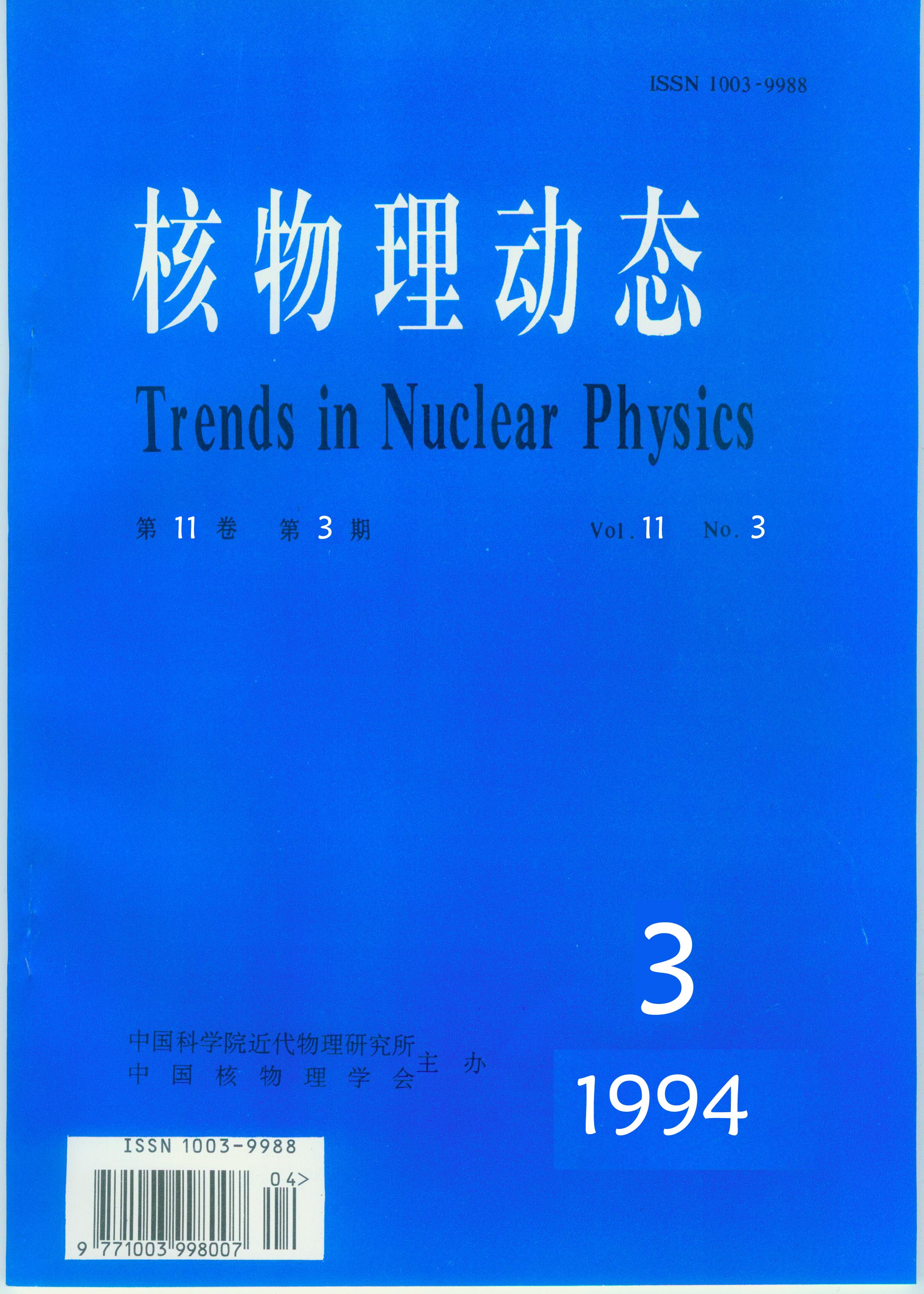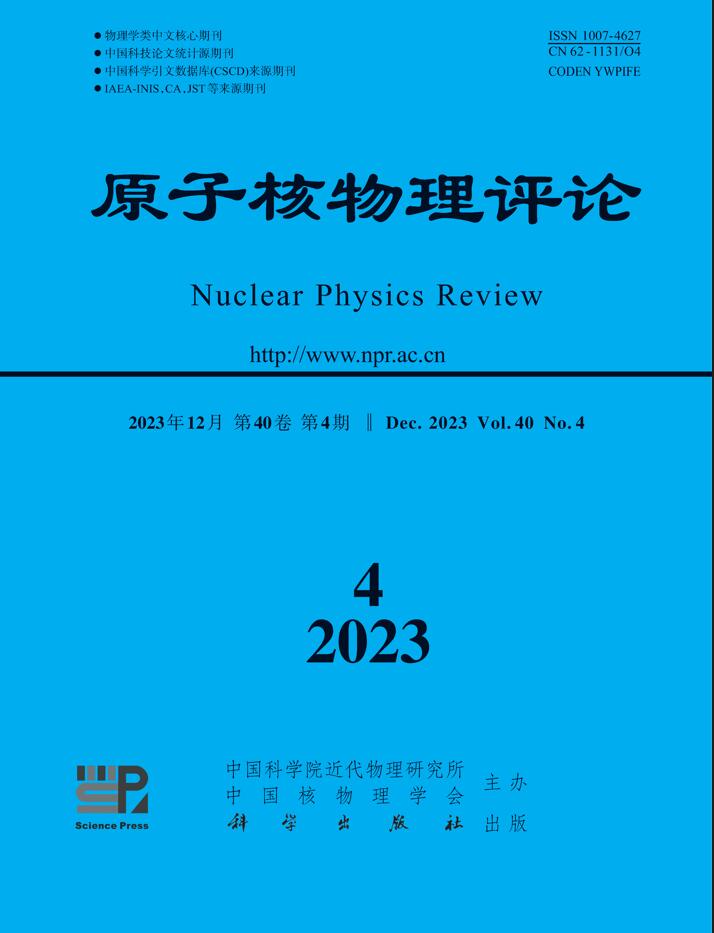1994 Vol. 11, No. 3

Display Method:
1994, 11(3): 1-16.
doi: 10.11804/NuclPhysRev.11.03.001
Abstract:
A survey of the first experimental results for the study of central An (100~800 MeV/u) on An collisions with FOPI at SIS/ESR was presented and discussed. Highlycentral collisions have been studied by using a double selection criterion which combines largecharged particle multiplicities with small transverse momentum directivities and using the ratio of the sum of transversal kinetic energies to the sum of the longitudinal kinetic energies;Based on these selections, were obtained, for...
A survey of the first experimental results for the study of central An (100~800 MeV/u) on An collisions with FOPI at SIS/ESR was presented and discussed. Highlycentral collisions have been studied by using a double selection criterion which combines largecharged particle multiplicities with small transverse momentum directivities and using the ratio of the sum of transversal kinetic energies to the sum of the longitudinal kinetic energies;Based on these selections, were obtained, for...
1994, 11(3): 17-22.
doi: 10.11804/NuclPhysRev.11.03.017
Abstract:
Traditional theoretical investigations of the hadron-scattering cross sections ina wide range of nuclei in the intermediate-energy region (above 400MeV) have revealed obvious discrepancies with the existing experimental data. It is about 20% lower than the datafor hadronic probes such as proton,pion and kaon. For proton-nucleus sacattering, an agreement with experiment may significantly be improved by introduction of relativistic dynamices. For meson probes, however...
Traditional theoretical investigations of the hadron-scattering cross sections ina wide range of nuclei in the intermediate-energy region (above 400MeV) have revealed obvious discrepancies with the existing experimental data. It is about 20% lower than the datafor hadronic probes such as proton,pion and kaon. For proton-nucleus sacattering, an agreement with experiment may significantly be improved by introduction of relativistic dynamices. For meson probes, however...
1994, 11(3): 23-26.
doi: 10.11804/NuclPhysRev.11.03.023
Abstract:
Based on the single-particle levels given by Nilsson,the intrinsic and effective(with collective effects)level density parameters as a function of theexcitation energy for the 186Os, 187Ir, 189Os and 193Au deformation nuclei have been calculatedin the range of the excitation energy up to 150MeV. The calculated fission probabilities Pf(U) are consistent satisfactorily with the experimental data when a nonadiabtic estimation ofthe collective effects was used to calculate the nuclear level density parameters.
Based on the single-particle levels given by Nilsson,the intrinsic and effective(with collective effects)level density parameters as a function of theexcitation energy for the 186Os, 187Ir, 189Os and 193Au deformation nuclei have been calculatedin the range of the excitation energy up to 150MeV. The calculated fission probabilities Pf(U) are consistent satisfactorily with the experimental data when a nonadiabtic estimation ofthe collective effects was used to calculate the nuclear level density parameters.
1994, 11(3): 27-31.
doi: 10.11804/NuclPhysRev.11.03.027
Abstract:
The fission diffusion model is introduced. The diffusion process with lightparticle emission is expressed by extensive Smoluchowski equation. The calculation showsthe time dependence of the fission rate and the existence of transient process. The transientprocess is very important in high energy heavy ion collisions and leads to the enhancement ofthe light particle emission. The particle multiplicity is also given which depends on nucleartemperature and nuclear friction constant. For ...
The fission diffusion model is introduced. The diffusion process with lightparticle emission is expressed by extensive Smoluchowski equation. The calculation showsthe time dependence of the fission rate and the existence of transient process. The transientprocess is very important in high energy heavy ion collisions and leads to the enhancement ofthe light particle emission. The particle multiplicity is also given which depends on nucleartemperature and nuclear friction constant. For ...
1994, 11(3): 32-37.
doi: 10.11804/NuclPhysRev.11.03.032
Abstract:
some problems in recent progress of Fullerene studies are discussed in this paper. They are: the mass distributions of Fullerenes, the isomers and chiral allotropes ofFullerenes, the microtubules of graphitic carbon,the growth morphology and the dynamics ofFullerenes, and so on. These problems are some very interesting in the Fullerenes studies.
some problems in recent progress of Fullerene studies are discussed in this paper. They are: the mass distributions of Fullerenes, the isomers and chiral allotropes ofFullerenes, the microtubules of graphitic carbon,the growth morphology and the dynamics ofFullerenes, and so on. These problems are some very interesting in the Fullerenes studies.
1994, 11(3): 38-43.
doi: 10.11804/NuclPhysRev.11.03.038
Abstract:
This paper gives a systemic review on the recent progress in the study of irradiation effects in ferrite induced by energetic heavy ions, and also gives a suggestion thatsome experiments in this field can be carried out further by Heavy Ion Reseach Facility ofLanzhou(HIRFL ).
This paper gives a systemic review on the recent progress in the study of irradiation effects in ferrite induced by energetic heavy ions, and also gives a suggestion thatsome experiments in this field can be carried out further by Heavy Ion Reseach Facility ofLanzhou(HIRFL ).
1994, 11(3): 44-49.
doi: 10.11804/NuclPhysRev.11.03.044
Abstract:
Historical background and trends at home and abroad for radiation therapy arelooked back in the paper. The advantages of heavy ion beam in comparision with conventional radiation in tumour treatment are discussed. The main parameters of heavy ion beams fortherapy application and a tentative idea constructing treatment rooms at Cooling StorageRing(CSR) of Heavy Ion Research Facility in Lanzhou (HIRFL) are proposed.
Historical background and trends at home and abroad for radiation therapy arelooked back in the paper. The advantages of heavy ion beam in comparision with conventional radiation in tumour treatment are discussed. The main parameters of heavy ion beams fortherapy application and a tentative idea constructing treatment rooms at Cooling StorageRing(CSR) of Heavy Ion Research Facility in Lanzhou (HIRFL) are proposed.
1994, 11(3): 50-52.
doi: 10.11804/NuclPhysRev.11.03.050
Abstract:
Two sets of solid β-ray telescopes of different type were bunt and used successfully in experiments.. This paper gives examples of two telescopes to describe the featureof solid β-ray detectors and their important function in experiments of nuclear physics.
Two sets of solid β-ray telescopes of different type were bunt and used successfully in experiments.. This paper gives examples of two telescopes to describe the featureof solid β-ray detectors and their important function in experiments of nuclear physics.
1994, 11(3): 53-57.
doi: 10.11804/NuclPhysRev.11.03.053
Abstract:
The paper introduces a new detection technique being quickly developed──wavelength dispersive position sensitive spectrometer with a flat crystal in the area of low energy X-ray analysis, its basic principle, related technology and applications. The development prospects and the future study are also discussed.
The paper introduces a new detection technique being quickly developed──wavelength dispersive position sensitive spectrometer with a flat crystal in the area of low energy X-ray analysis, its basic principle, related technology and applications. The development prospects and the future study are also discussed.
1994, 11(3): 58-61.
doi: 10.11804/NuclPhysRev.11.03.058
Abstract:
This paper briefly introduces the developing trends of the experimental instruments,the study direction and the quantitative analysis methods on X-Ray Spectrometry(XRS).Although XRS is an old field in the application of nuclear technique, the recent progresses, in various forms of XRS, are dramatic. XRS is now a powerful and well establishedanalytical technique for routine analysis of samples and study of material fine structures.
This paper briefly introduces the developing trends of the experimental instruments,the study direction and the quantitative analysis methods on X-Ray Spectrometry(XRS).Although XRS is an old field in the application of nuclear technique, the recent progresses, in various forms of XRS, are dramatic. XRS is now a powerful and well establishedanalytical technique for routine analysis of samples and study of material fine structures.
1994, 11(3): 62-66.
doi: 10.11804/NuclPhysRev.11.03.062
Abstract:
The development and present situation of the domestic and international nuclear data libraries, especially experimental neutron library and evaluated neutron library forgeneral purpose are introduced. The internationally used formats concerned and how to usethem for home users are presented.
The development and present situation of the domestic and international nuclear data libraries, especially experimental neutron library and evaluated neutron library forgeneral purpose are introduced. The internationally used formats concerned and how to usethem for home users are presented.







 甘公网安备 62010202000723号
甘公网安备 62010202000723号